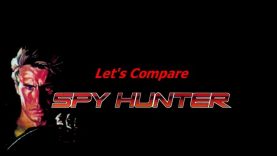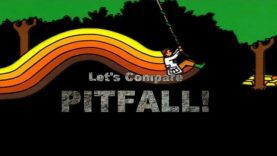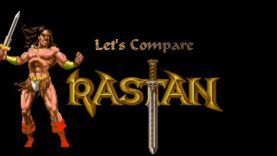Let’s Compare ( Dig Dug ) REMAKE
Gaming History Source
Video Locations:
Arcade 0:49
Arcade 2:14 ( Namco Classic Collection )
Atari 2600 3:50
Apple 2 5:14
DOS 6:40
Vic 20 8:04
NEC PC-8801 9:29
Casio PV-1000 10:55
Intellivision 12:21
Atari 8 bit 800/XE/XL 13:46
Atari 5200 15:11
Commodore 64 16:36
TI99 18:02
Gameboy ( Old ) 19:27
Gameboy ( New ) 20:51
MSX 22:17
Colecovision 23:41
Atari 7800 25:06
Famicom 26:32
Fujitsu FM-7 27:57
Gameboy Advance 29:22
Dreamcast / Nintendo 64 ( Namco Museum ) 30:47
Sharp X68000 32:11
Windows ( Dig Dug Roswell ) 33:36
Xbox / Playstation 2 / Gamecube ( Namco Museum ) Classic 35:02
Xbox / Playstation 2 / Gamecube ( Namco Museum ) Modern 36:27
Xbox 360 / Apple IOS 38:01
Description Source:
http://en.wikipedia.org/wiki/Dig_Dug
Dig Dug (????? Digu Dagu?) is an arcade game developed and published by Namco in Japan in 1982 for Namco Galaga hardware. It was later published outside of Japan by Atari. A popular game based on a simple concept, it was also released as a video game on many consoles.
Objective:
Objective
The objective of Dig Dug is to eliminate underground-dwelling monsters by inflating them until they pop, or by dropping rocks on them. There are two kinds of enemies in the game: Pookas, round red monsters (said to be modeled after tomatoes) who wear yellow goggles, and Fygars, green dragons who can breathe fire. The player’s character is Dig Dug, dressed in white and blue, and able to dig tunnels through destructible environments. Dig Dug is killed if he is caught by either Pooka or Fygar, burned by a Fygar’s fire, or crushed by a rock.
A partially inflated monster will gradually deflate and recover after a few seconds, during which time the player can pass safely through it. The monsters normally crawl through the tunnels in the dirt but can turn into ghostly eyes and travel slowly through the dirt. The last enemy on a level will try to escape off the top left of the screen.
More points are awarded for popping an enemy further down in the dirt (the levels are color-coded). In addition, Fygars are worth double points if exploded horizontally, since they can only breathe fire horizontally in the direction they are facing. Extra points are also awarded for dropping rocks on enemies in order to eliminate them rather than inflating them. If one enemy is killed by the rock, it is worth 1000 points. The next two add 1500 points each, and any after that add 2000. The act of digging is itself worth points, giving 10 points for each block dug, so some players do as much of it as possible in situations where the threat from the remaining monsters is minimal.
After the player drops two rocks, fruits and vegetables and other edible bonus items, such as Galaxian flagships appear in the center of the play field, and can be collected for points if the player is able to reach them before they disappear. These edible bonus items will appear even if the rocks fail to hit any enemies. In some versions of the game, the most points attainable from a single bonus fruit is 8,000 from the pineapple.
If the player drops a rock on a foe at the same time he pumps it to death, a glitch will occur whereupon all enemies will promptly disappear, but the game will not progress and the player will be free to dig through all dirt. Attaining the next level of play will then remain impossible, but the glitch can be resolved by forcing a rock to drop.
Level numbers are represented by flowers in the top right of the screen and each new level is noted at the beginning of each stage on the bottom right (as seen in this article’s screenshot graphic). In successive levels more monsters appear on each screen and they move quicker. A level is completed successfully when the last monster is dispatched or succeeds in fleeing.
In the coin-operated version the game ends on round 256 (round 0), since this board is essentially an unplayable kill screen. At the start of the level a Pooka is placed directly on top of where the player starts, with no way to kill it.













